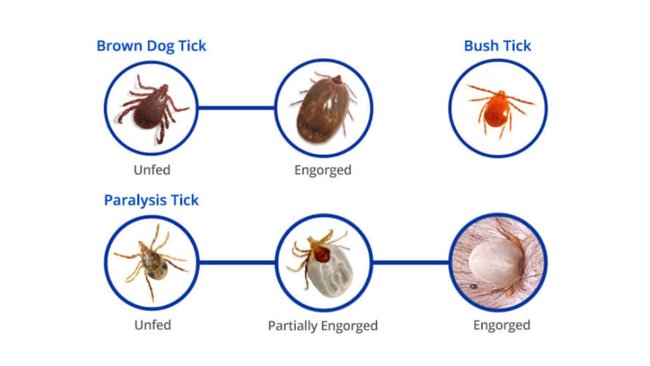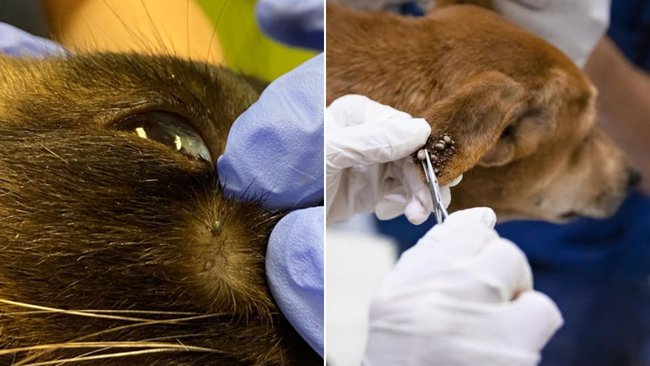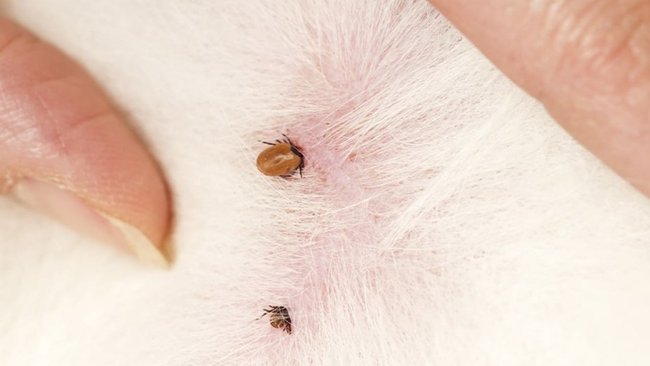A little cavoodle named Hanuman is rushed to emergency care in a critical condition, with his owners fearing he will not make it.
The one-and-a-half-year-old fluffy companion was suffering from severe tick paralysis.
Unfortunately, Hanuman’s case is far from isolated.
Know the news with the 7NEWS app: Download today
Numerous dogs and cats are fighting for their lives while veterinary clinics are pushed to their limits amid a sharp spike in tick paralysis cases.
Southeast Queensland has been hit hard, with the Animal Welfare League Queensland (AWLQ) reporting a surge in cases across the Gold Coast, Brisbane and Ipswich.
Paralysis ticks are blood-sucking parasites which attach themselves to animals and release a neurotoxin, which can quickly lead to serious illness or even death if left untreated.
Ticks vary between 1mm and 10mm long, depending on age. They look like tiny spiders with white, egg-shaped bodies. This body becomes more prominent and darker as it fills with blood.
 Common ticks found across Australia vary in size and appearance but all pose a risk to pets. This graphic shows how ticks look before feeding and how they swell after drawing blood, increasing the danger of tick paralysis. Credit: Nexguard
Common ticks found across Australia vary in size and appearance but all pose a risk to pets. This graphic shows how ticks look before feeding and how they swell after drawing blood, increasing the danger of tick paralysis. Credit: Nexguard
The AWLQ’s Gold Coast clinic recorded 33 cases of tick paralysis in September alone, including 14 in one week at a devastatingly high mortality rate of 43 per cent.
According to AWLQ, the sudden spike is being fuelled by unseasonably warm weather combined with a drop in pet owners using preventatives.
Dr Dia Charalambous, from AWLQ’s Gold Coast Community Vet Clinic, said early-season tick cases tend to be more aggressive.
Brisbane has reported 12 cases since August, nearly half of them fatal.
Ipswich has seen 10 cases in the same period, though no deaths have been reported there yet.
Pet owners are being reminded to keep tick preventatives up to date and to check their pets thoroughly every day.
 Ticks latch onto cats and dogs, feeding on their blood and releasing toxins that can cause serious paralysis if not treated quickly. Credit: Sashvet/Four Paws
Ticks latch onto cats and dogs, feeding on their blood and releasing toxins that can cause serious paralysis if not treated quickly. Credit: Sashvet/Four Paws
Once paralysis occurs, the animal is likely to die unless treated quickly with tick anti-serum transfused by a vet, and full recovery can take weeks.
“Prevention is a lot better and cheaper than cure. Ensuring your dog or cat is consistently up-to-date with their tick prevention medication is paramount,” Charalambous said.
Treating tick paralysis can cost thousands of dollars and often involves intensive care, anti-serum, and even mechanical ventilation.
“By the time pets reach us, paralysis can progress rapidly, making treatment difficult and very expensive,” Charalambous said.
“Advanced cases require 24-hour emergency care, including ventilation, which general practices can’t provide.
“It’s heartbreaking to see so many preventable cases.”
In contrast, preventative options — including tick collars, oral medications and spot-on treatments — typically cost less than $100 for several months’ coverage.
“There are many effective tick prevention options for dogs and cats. We urge all pet owners to visit their local veterinary clinics or pet shops now to protect their pets,” Charalambous added.
“The cost of prevention is minor compared with the expense and heartbreak of tick paralysis treatment.”
 Ticks are small parasites that latch onto pets to feed on their blood, often hiding in bushy or grassy areas across Australia. Credit: Nexguard
Ticks are small parasites that latch onto pets to feed on their blood, often hiding in bushy or grassy areas across Australia. Credit: Nexguard
Hanuman was one of the severe cases.
He was rushed to the Gold Coast clinic already severely paralysed and required urgent emergency care.
After being transferred to a 24-hour emergency facility, Hanuman underwent a week of intensive treatment before finally pulling through.
His owner called the ordeal “extremely stressful and emotional” and is now urging others not to take chances with prevention.
AWLQ vets say most of the current cases are coming from specific high-risk postcodes, including 4211, 4209, 4213, 4270, and 4305. Many clinics in those areas are now at capacity.
Pet owners are being urged to stay alert for early signs of tick paralysis, which can include:
Vomiting or dry retchingLethargyLoss of appetiteExcessive salivatingCoughing or loud pantingWobbly gaitWeakness in the hind limbs, which may progress to total paralysis
Ticks are commonly found in bushland and scrubby areas. Avoiding these habitats where possible can also reduce the risk.
“When the tick first attaches, there are often no visible symptoms,” AWLQ warns.
“If you can find and remove the tick before enough toxin is injected, you can potentially prevent paralysis altogether.”
How to remove a tick safely
Vets recommend to remove ticks as soon as possible using a tick removal tool or fine-tipped tweezers.
Grip the tick close to the skin and twist or pull gently.Do not squeeze or leave the head behind as this can cause infection and allow toxins to enter.Tick removal tools are available at vets and pet stores. If you are unsure, ask your vet for help.Never burn or smother ticks.If you find a tick or notice symptoms, seek veterinary care immediately.
When removing a tick yourself, keep the tick and take it with you to the clinic for identification.
To learn more about tick prevention or to find a clinic, visit awlqld.com.au/vet-clinics.
Family pet’s dramatic outback rescue
1 min read
Fury as dog owner leaves puppy panting in car on sweltering day
2 min read

